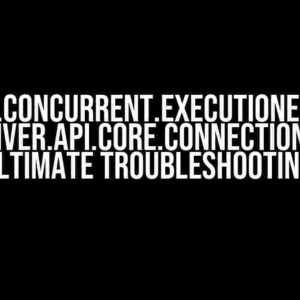Are you tired of dealing with pesky issues in your Spring application, where your neatly crafted configuration files seem to be at odds with each other? Do you find yourself scratching your head, wondering why your carefully crafted `@Value` annotations are not being injected correctly? Well, wonder no more! In this comprehensive guide, we’ll delve into the world of Spring ‘Value’ resource wiring inconsistencies, and explore the reasons behind these frustrating errors. Buckle up, folks, and let’s dive in!
What are Spring ‘Value’ Resource Wiring Inconsistencies?
Before we dive into the meat of the matter, let’s define what we’re talking about. In Spring, the `@Value` annotation is used to inject values from a properties file or a configuration class into a Spring bean. This is a powerful feature that allows for loose coupling and flexibility in your application configuration. However, when things go awry, you might encounter issues with resource wiring inconsistencies.
Resource wiring inconsistencies occur when the `@Value` annotation is not properly injected, resulting in errors, null pointer exceptions, or unexpected behavior in your application. This can be due to a variety of reasons, including:
- typos in property names or file paths
- incorrect configuration file locations or naming conventions
- conflicting property values or bean definitions
- issues with dependency injection or autowiring
- and many more!
Common Scenarios and Error Messages
So, how do you know if you’re dealing with a Spring ‘Value’ resource wiring inconsistency? Here are some common scenarios and error messages to watch out for:
Scenario 1: Missing or Incorrect Property Files
org.springframework.beans.factory.BeanCreationException:
Error creating bean with name 'myBean':
Injection of autowired dependencies failed;
nested exception is java.lang.IllegalArgumentException:
Could not resolve placeholder 'my.property' in value "${my.property}"
In this scenario, the error message indicates that the `my.property` value cannot be resolved, likely due to a missing or incorrect properties file.
Scenario 2: Typo in Property Name or File Path
org.springframework.beans.factory.BeanCreationException:
Error creating bean with name 'myBean':
Injection of autowired dependencies failed;
nested exception is java.lang.IllegalArgumentException:
Could not resolve placeholder 'my.proprty' in value "${my.proprty}"
Notice the typo in the property name (`my.proprty` instead of `my.property`)? This can lead to a similar error message as above.
Scenario 3: Conflicting Property Values or Bean Definitions
org.springframework.beans.factory.BeanDefinitionStoreException:
Invalid bean definition with name 'myBean':
Could not resolve placeholder 'my.property' in value "${my.property}";
nested exception is java.lang.IllegalArgumentException:
Could not resolve placeholder 'my.property' in value "${my.property}"
In this scenario, the error message indicates that there’s a conflict between different property values or bean definitions, leading to an invalid bean definition.
Troubleshooting and Resolution Strategies
Now that we’ve covered the common scenarios and error messages, let’s dive into some troubleshooting and resolution strategies to help you overcome Spring ‘Value’ resource wiring inconsistencies:
Step 1: Verify Property Files and Locations
Double-check your properties files and locations to ensure they match the expected naming conventions and folder structures. Make sure to check for typos in property names and file paths.
Step 2: Review Configuration Files and Bean Definitions
Inspect your configuration files (e.g., `application.properties` or `application.yml`) and bean definitions to identify any conflicting property values or bean definitions. Ensure that there are no duplicate or conflicting definitions.
Step 3: Use the `@PropertySource` Annotation
When using `@Value` annotations, make sure to specify the correct property source using the `@PropertySource` annotation. This can help Spring resolve the correct property values.
@Configuration
@PropertySource("classpath:application.properties")
public class MyConfig {
@Value("${my.property}")
private String myProperty;
// ...
}
Step 4: Enable Debug Logging
Enable debug logging in your Spring application to get more detailed information about the error. This can help you identify the root cause of the issue.
logging.level.org.springframework=DEBUG
Step 5: Use a Consistent Naming Convention
Establish a consistent naming convention for your properties, files, and bean definitions. This can help prevent typos and reduce the likelihood of resource wiring inconsistencies.
Best Practices for Avoiding Spring ‘Value’ Resource Wiring Inconsistencies
To avoid Spring ‘Value’ resource wiring inconsistencies in the first place, follow these best practices:
| Best Practice | Description |
|---|---|
| Use a consistent naming convention | Establish a consistent naming convention for properties, files, and bean definitions to reduce the likelihood of typos and errors. |
| Verify property files and locations | Double-check property files and locations to ensure they match the expected naming conventions and folder structures. |
| Use the `@PropertySource` annotation | Specify the correct property source using the `@PropertySource` annotation to help Spring resolve the correct property values. |
| Enable debug logging | Enable debug logging in your Spring application to get more detailed information about errors and issues. |
| Test thoroughly | Test your application thoroughly to catch any resource wiring inconsistencies or errors early on. |
Conclusion
In this comprehensive guide, we’ve delved into the world of Spring ‘Value’ resource wiring inconsistencies, exploring the common scenarios, error messages, and troubleshooting strategies to help you overcome these frustrating errors. By following the best practices outlined above, you can reduce the likelihood of resource wiring inconsistencies and ensure a smoother development experience.
Remember, a well-crafted Spring application is all about attention to detail, consistency, and thorough testing. By being vigilant and proactive, you can avoid the headaches associated with Spring ‘Value’ resource wiring inconsistencies and focus on building robust, scalable, and maintainable applications.
Happy coding, and see you in the next article!
Frequently Asked Question
Get ready to untangle the mysteries of Spring ‘Value’ resource wiring inconsistencies!
What are Spring ‘Value’ resource wiring inconsistencies?
Spring ‘Value’ resource wiring inconsistencies occur when the @Value annotation is used to inject values from a properties file, but the values are not correctly resolved or injected into the application context. This can lead to errors, null pointer exceptions, or unexpected behavior in the application.
What are the common causes of Spring ‘Value’ resource wiring inconsistencies?
Common causes include typos in the properties file, incorrect file paths, missing or incorrect configuration, and version conflicts between Spring dependencies. Additionally, issues with the application context, such as incorrect bean definitions or incomplete autowiring, can also lead to inconsistencies.
How can I troubleshoot Spring ‘Value’ resource wiring inconsistencies?
To troubleshoot, start by reviewing the properties file and configuration to ensure accuracy and completeness. Enable debug logging to see the actual values being injected. Use tools like the Spring Boot DevTools or the Eclipse debugger to inspect the application context and bean definitions. Finally, simplify the configuration and test individual components to isolate the issue.
Can I use alternative approaches to overcome Spring ‘Value’ resource wiring inconsistencies?
Yes, alternative approaches include using constructor injection, method injection, or field injection instead of the @Value annotation. You can also use aConfigurableEnvironment to externalize configuration or utilize a third-party library like Apache Commons Configuration. Additionally, consider using a more robust configuration management system, such as Spring Cloud Config or Apache ZooKeeper.
How can I prevent Spring ‘Value’ resource wiring inconsistencies in the future?
To prevent inconsistencies, follow best practices such as using a consistent naming convention, keeping configurations organized and well-documented, and regularly reviewing and testing the application context. Additionally, consider implementing automated testing and continuous integration to catch errors early in the development cycle.



